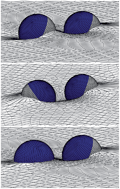Capillary interactions between spherical Janus particles at liquid–fluid interfaces
Abstract
We study the interactions of spherical Janus particles at non-equilibrium orientations adsorbed at flat oil–

* Corresponding authors
a Department of Mechanical and Aerospace Engineering, Rutgers, The state University of New Jersey, Piscataway, NJ 08854, USA
b
Institute for Advanced Materials, Devices and Nanotechnology, Rutgers, The state University of New Jersey, Piscataway, NJ 08854, USA
E-mail:
zadeh@rutgers.edu
We study the interactions of spherical Janus particles at non-equilibrium orientations adsorbed at flat oil–

 Please wait while we load your content...
Something went wrong. Try again?
Please wait while we load your content...
Something went wrong. Try again?
H. Rezvantalab and S. Shojaei-Zadeh, Soft Matter, 2013, 9, 3640 DOI: 10.1039/C3SM27380F
To request permission to reproduce material from this article, please go to the Copyright Clearance Center request page.
If you are an author contributing to an RSC publication, you do not need to request permission provided correct acknowledgement is given.
If you are the author of this article, you do not need to request permission to reproduce figures and diagrams provided correct acknowledgement is given. If you want to reproduce the whole article in a third-party publication (excluding your thesis/dissertation for which permission is not required) please go to the Copyright Clearance Center request page.
Read more about how to correctly acknowledge RSC content.
 Fetching data from CrossRef.
Fetching data from CrossRef.
This may take some time to load.
Loading related content
